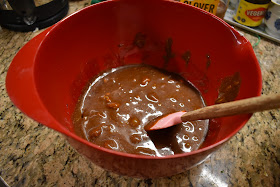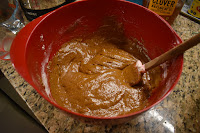A soft gingerbread that's good for all seasons!
Continuing the trend of making recipes from cookbooks I've long wanted to test out is this unique gingerbread recipe from The President's Cookbook, a cookbook from the 1960's that features interpretations of recipes enjoyed by First Families past and present. As I've said before, Presidential cooking has long been something that's fascinated the American public, and food enjoyed at the White House can influence national trends and introduce new ingredients or dishes to the public.
This recipe is a modern interpretation of a soft gingerbread Dolley Madison was famous for. The cookbook notes that Dolley herself referred to it as "Jefferson's gingerbread", and she gave the recipe to Martha Washington, who recorded it for her own use. That's the copy that made its way into this cookbook, so it's got a pretty long history and an association with quite a few of the Founding Fathers - and more importantly, their wives and slaves who would have been the ones actually planning and preparing these fancy meals. Read on to find out more about this historic recipe!
This recipe is a modern interpretation of a soft gingerbread Dolley Madison was famous for. The cookbook notes that Dolley herself referred to it as "Jefferson's gingerbread", and she gave the recipe to Martha Washington, who recorded it for her own use. That's the copy that made its way into this cookbook, so it's got a pretty long history and an association with quite a few of the Founding Fathers - and more importantly, their wives and slaves who would have been the ones actually planning and preparing these fancy meals. Read on to find out more about this historic recipe!
Dolley Madison was a hugely influential First Lady, famous for making things like ice cream popular with the American upper class - which we talked about in one of our early Caroline posts! While Caroline might not personally have read about or enjoyed all of the dishes Mrs. Madison used to make her White House dinners so highly regarded, this recipe is something so standard that it's not hard to imagine that Caroline probably would have eaten something similar in Sackets Harbor. Gingerbread was a staple of early American cuisine, and this recipe uses one particular ingredient that's very representative of colonial and post colonial America - molasses!
Molasses is one of the byproducts of sugar production, and shipments of the dark brown sticky stuff came from the Caribbean to the American colonies to be used as a sugar substitute or to be processed into rum. Molasses was generally much cheaper to use than white sugar, an expensive and therefore precious ingredient for dessert recipes. This recipe calls for no other sweeteners, but uses a whole lot of molasses. A flavorful cake that puts a cheaper ingredient to good use is just as valuable to a middle class family like the Abbotts as to the First Lady of the United States - it's totally possible that this is a recipe Mrs. Madison was making or learned about when she was Caroline's age, too!
To star off, combine 2 1/2 cups of flour, a whopping 4 teaspoons of ginger, and 1 tablespoon of cinnamon in a mixing bowl. In a separate bowl, combine 1 cup of molasses and 2/3 of beef drippings or lard. You can substitute that with butter or shortening if you don't have drippings or lard handy.
Molasses is one of the byproducts of sugar production, and shipments of the dark brown sticky stuff came from the Caribbean to the American colonies to be used as a sugar substitute or to be processed into rum. Molasses was generally much cheaper to use than white sugar, an expensive and therefore precious ingredient for dessert recipes. This recipe calls for no other sweeteners, but uses a whole lot of molasses. A flavorful cake that puts a cheaper ingredient to good use is just as valuable to a middle class family like the Abbotts as to the First Lady of the United States - it's totally possible that this is a recipe Mrs. Madison was making or learned about when she was Caroline's age, too!
To star off, combine 2 1/2 cups of flour, a whopping 4 teaspoons of ginger, and 1 tablespoon of cinnamon in a mixing bowl. In a separate bowl, combine 1 cup of molasses and 2/3 of beef drippings or lard. You can substitute that with butter or shortening if you don't have drippings or lard handy.
Next, the recipe instructs you to dissolve 1 1/4 teaspoons of baking soda in 1/4 of a cup of hot, almost boiling water before mixing it in with the molasses and fat mixture. This is the one part of the recipe that isn't wholly historically authentic, as chemical leavening agents were still a few decades in the future during the War of 1812. Cakes got their fluffiness and rise from eggs, or potash, also known as pearl ash, which is a processed form of the ashes you'd have left over after a fire. Potash was only used in baking from about 1780 to 1840, when commercially produced leavening agents became available.
After this is mixed in, alternate adding the dry ingredients with 3/4 of a cup of hot water until everything is well mixed and combined.
The batter will be really light, as will the resulting cake, so I'd definitely recommend greasing, flouring, and lining the tin with some parchment paper just to be extra sure your cake will come out clean. This bakes in the oven for about 30-40 minutes in a 350 degree oven.
After this is mixed in, alternate adding the dry ingredients with 3/4 of a cup of hot water until everything is well mixed and combined.
The batter will be really light, as will the resulting cake, so I'd definitely recommend greasing, flouring, and lining the tin with some parchment paper just to be extra sure your cake will come out clean. This bakes in the oven for about 30-40 minutes in a 350 degree oven.
I made this cake twice, and both times the resulting cake was very, very soft, and really fragile, so I definitely recommend caution while taking it out of the pan. Here's a picture of the second cake, which held up better than the first, but still had some pretty severe structural cracks after being in the oven. Most of the big cracks you see in this picture are actually huge fissures.
I was able to cut a pretty nice looking piece for photographs, though!
So, first off: this cake smells amazing while it's baking. It has a ton of spices in it, and it makes your entire house smell like the holidays while it's in the oven. I would pretty much recommend baking it for that reason alone.
Fortunately, it's not just the smell that's pretty great - the flavor really comes through and it's a beautifully soft, melt in your mouth cake. It's not an especially sweet cake, which might be a turn off for a modern audience with a sweet tooth, but the molasses flavor is really amazing and the spices come through very strongly, so it's definitely not a flavorless cake. Like a lot of the historical cakes I've made on this blog, its "just a little sweet" profile makes it partner well with a hot cup of coffee or tea.
It was also extremely easy to make and didn't require too many ingredients. I can totally see how this would be something Caroline's mom or grandma would like to whip up when they were expecting company because it's extremely tasty, but doesn't require a lot of fussing to get it ready.
Despite the slight frustration trying to get this cake out of the pan, this was a really fun recipe to make and enjoy. I brought in the leftovers to my office and my coworkers all really liked it as well, so it's definitely not hard to imagine how it might have been a favorite of three different First Families!
With the weather finally starting to warm up for spring, it's probably time to shelve the spice heavy recipes, but this was a fun last one to try out before the temperatures start firmly climbing up and up and up! How are you spending the (hopefully) last few days of winter weather?
Fortunately, it's not just the smell that's pretty great - the flavor really comes through and it's a beautifully soft, melt in your mouth cake. It's not an especially sweet cake, which might be a turn off for a modern audience with a sweet tooth, but the molasses flavor is really amazing and the spices come through very strongly, so it's definitely not a flavorless cake. Like a lot of the historical cakes I've made on this blog, its "just a little sweet" profile makes it partner well with a hot cup of coffee or tea.
It was also extremely easy to make and didn't require too many ingredients. I can totally see how this would be something Caroline's mom or grandma would like to whip up when they were expecting company because it's extremely tasty, but doesn't require a lot of fussing to get it ready.
Despite the slight frustration trying to get this cake out of the pan, this was a really fun recipe to make and enjoy. I brought in the leftovers to my office and my coworkers all really liked it as well, so it's definitely not hard to imagine how it might have been a favorite of three different First Families!
With the weather finally starting to warm up for spring, it's probably time to shelve the spice heavy recipes, but this was a fun last one to try out before the temperatures start firmly climbing up and up and up! How are you spending the (hopefully) last few days of winter weather?
Hopefully it's with something equally comforting and tasty!













No comments:
Post a Comment